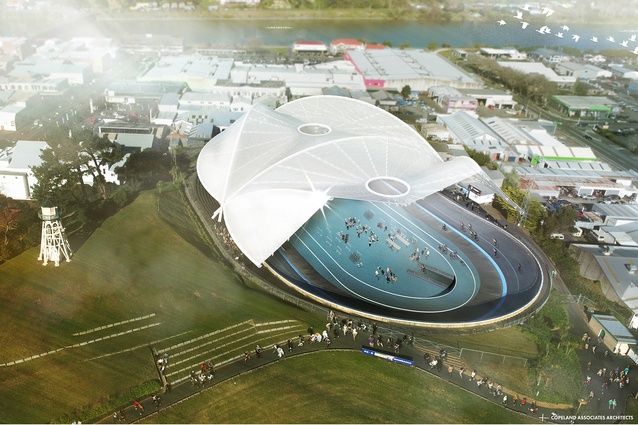Velodrome plan spins its wheels
A design consortium has spent the past 15 years working on a scheme to cover and upgrade Whanganui’s 26-year-old velodrome, which is in a state of disrepair. The fate of the plan came down to a split vote.
Designed and built by former cycling champion and London Olympic track designer Ron Webb, the Whanganui velodrome, with its world-class Malaysian hardwood track, was considered one of the world’s fastest when it opened in 1995. Webb signalled at the time that the track would need to be covered within five years to preserve the integrity of the structure.
An Opus pitch to build a roof over the velodrome in 2000 was turned down by the Whanganui District Council and, since 2007, a consortium has offered up several design iterations to upgrade and cover the track, and extend its use to a wider recreational facility.

A multi-use, covered velodrome scheme, deriving from the structural principles of a bicycle wheel and including a 7000m2 tension-membrane roof structure incorporating steel cables and tubular arches, was put forward by Copeland Associates Architects. Its column-free design enabled the integration of a 200m roller-skating track inside the velodrome track, while also opening up the facility for wider community use.
Architect Barry Copeland says the $25-million design made for lower energy and running costs when compared to more conventional antecedents. The translucent shell, measuring 75m across by 135m long, offered natural light and ventilation, and the permeable wind screen enclosure and roof openings saved on the installation of costly mechanical ventilation plant and associated running costs.
The scheme, backed by the Regional Velodrome Development Trust, was first presented to the Whanganui District Council in 2015 and then again in May this year, where a split vote resulted in the motion to roof the velodrome being defeated. “This despite having been granted resource consent, having been promised government financial backing and having raised $2 million towards the cost of the project,” says Copeland, who hopes that, one day, the scheme will see the light of day.
Whanganui District Council Mayor Hamish McDouall admits that the decision would have been disappointing for many. “The Regional Velodrome Development Trust, the cycling community and others… have worked to realise this aspiration for the velodrome over many years,” he says. “I acknowledge that successive councils have failed to resolve the problem, largely because it was so difficult to make a convincing case to government. As a result, we have all been through two decades of frustration and debate.”
The velodrome is currently closed as a result of weather damage to the track rendering it unsafe for riders and, while its future remains uncertain, the council has put aside $2.5 million in funding “to complete some works,” says the council’s General Manager, Property and Open Spaces, Sarah O’Hagan.












